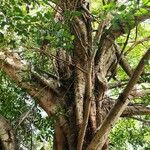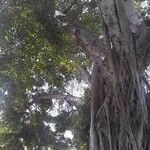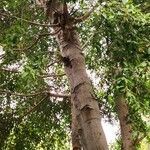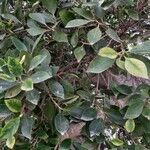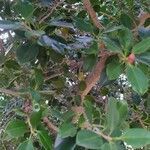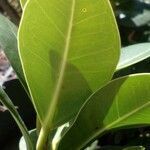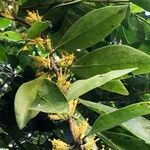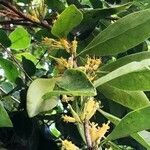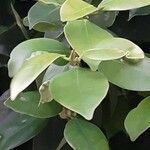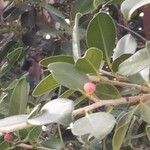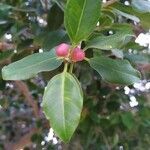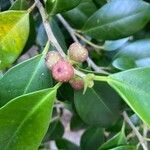Large banyan or straggler to 25 (–35) m high with copious aerial roots (often forming prop roots), often with flying buttresses, often originally epiphytic, or creeping shrub on exposed rocks, monoecious, exudate white. Leaves usually alternate; lamina narrowly to broadly elliptic to narrowly to broadly obovate or oblong-obovate, 2.5–12 cm long, 1.5–9 cm wide, narrowly to widely cuneate to rounded, often asymmetric at base, entire margin, obtuse or ± acute to shortly and bluntly acuminate at apex, usually glabrous; lateral veins 5–9 pairs, usually at an acute angle to midrib, rarely prominent (venation ± prominent beneath in former var. latifolia); petiole 2–20 mm long, channelled above, often puberulous, in former var. hillii somewhat articulated; stipules to 1.5 cm long, the margin puberulous. Figs paired, sessile, usually somewhat globose or depressed pyriform, 7–12 mm diam., cream, yellow, orange, pink or red, often ripening purple to black, internal bristles absent or few to many; ostiole enclosed by 2 or 3 flat apical bracts forming a disc 2–2.5 mm diam.; basal bracts 1.5–3 mm long and wide, puberulous. Flowers with 3 tepals; male and female sessile; gall flowers pedicellate.
Trees, 15-25 m tall, crown wide, d.b.h. to 50 cm. Bark dark gray. Branches producing rust-colored aerial roots when old. Stipules lanceolate, ca. 0.8 cm. Petiole 5-10 mm, glabrous; leaf blade narrowly elliptic, 4-8 × 3-4 cm, ± leathery, adaxially dark green and shiny but dark brown when dry, base cuneate, margin entire, apex ± obtuse; basal lateral veins long, secondary veins 3-10 on each side of midvein. Figs axillary on leafy branchlets or on leafless older branchlets, paired, yellow to slightly red when mature, depressed globose, 6-8 mm in diam., inside with a few short bristles among flowers, sessile; involucral bracts broadly ovate, persistent. Male, gall, and female flowers within same fig. Male flowers: scattered, sessile or pedicellate; filament as long as anther. Gall and female flowers: sepals 3, broadly ovate; style ± lateral; stigma short, clavate. Achenes ovoid. Fl. May-Jun.
A fig. It is an evergreen tree. It grows 15-25 m tall and spreads to 5 m across. The trunk can be 50 cm wide. The stem is erect and has buttresses. There are aerial roots. The bark is light grey and smooth. The branches are low and it has an open crown. It has a curtain of strangling roots. The leaves are dark green and shiny above and light green underneath. They are oval and pointed. They are 6-12 cm long by 2-7 cm wide. The leaf stalks are 0.5-1.5 cm long. The figs are rosy red or purple and round. They are produced singly or in pairs and are 1.2 cm across. They do not have fruit stalks. The fruit are edible. This plant varies considerably and 3 different varieties are known.
Trees , evergreen, to 30 m. Roots aerial, abundant, sometimes developing pillar-roots. Bark gray. Branchlets brown, glabrous. Leaves: stipules 0.7-0.9 cm; petiole 0.5-1 cm. Leaf blade elliptic, obovate to ovate, 3-11 × 1.5-6 cm, thinly leathery, base obtuse to cuneate, margins entire, apex nearly acute to acuminate; surfaces abaxially and adaxially glabrous; basal veins 1(-2) pairs; lateral veins 5-9 pairs, uniformly spaced. Syconia paired, sessile, purple or black, obovoid, pyriform, or nearly globose, 9-11 × 5-6 mm; subtending bracts ovate-lanceolate, 1.5-3.5 mm, apex obtuse to subacute; ostiole closed by 3 flat, apical bracts 2-2.5 mm wide, umbonate.
Tree. Blade elliptic to narrowly elliptic to obovate, up to 11 x 6 cm, apex shortly and faintly acuminate, base acute; secondary veins 4-10 pairs. Figs sessile, ca. 0.5-1 cm in diam., becoming bluish-black.
